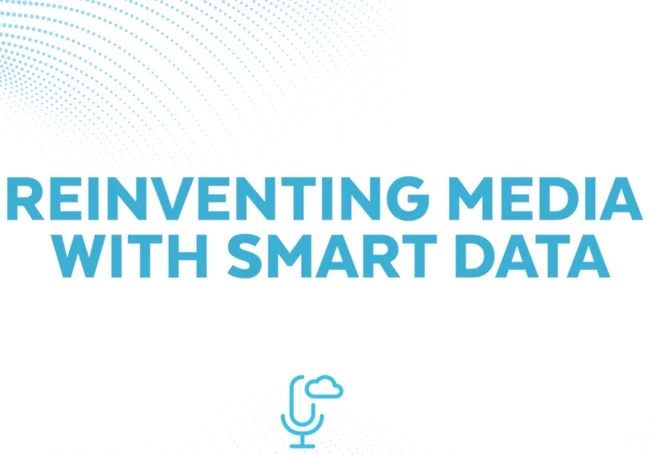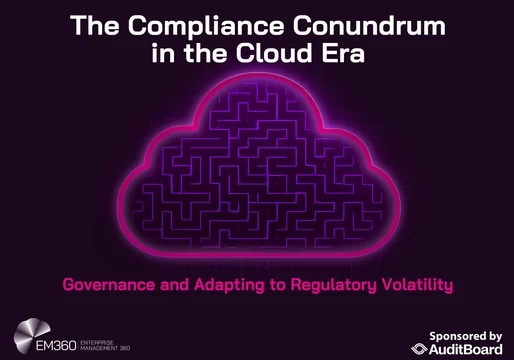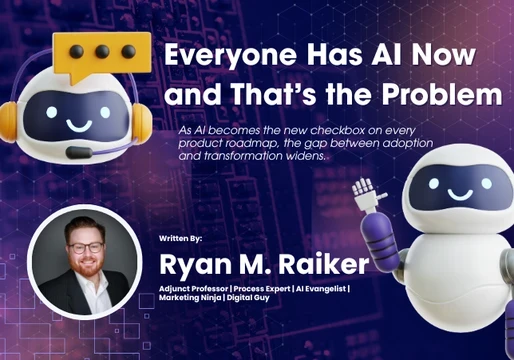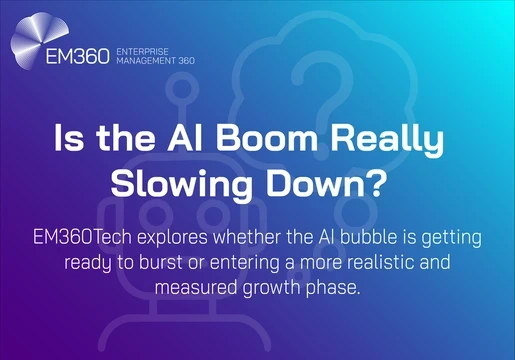In this interview with Travis Scoles, Executive Vice President of Advanced Advertising at Paramount, we discuss how Paramount leverages data, analytics, and AI to enhance advertising efficacy and maintain a competitive edge. The discussion also covers the integration of third-party data, the importance of privacy, and the evolution of targeted advertising.

Dana Gardner: Welcome to the Data Cloud podcast, Travis. We're delighted to have you with us.
Travis Scoles: Thank you, Dana.
Dana Gardner: Tell us about your role at Paramount Skydance. Your background in quantitative research, media analytics, and media optimization.
Travis Scoles: At Paramount, I lead advanced advertising, which is a great way to describe data-driven advertising. It's everything from Vantage, which is our audience targeting platform to measurement, innovation, identity strategy, the hard nuts and bolts of the data area.
My personal background is I was a data scientist. I worked at a consulting firm and ultimately moved into to product roles. Joined Paramount to lead product here for advanced advertising and, and now I run the function.
Dana Gardner: What excites you about the next five years in your area of expertise? What has you jazzed and happy to get up on Monday mornings?
Travis Scoles: In the media industry -- and especially for publishers like Paramount, who for a very long time had a very specific way of operating – we’ve been highly disrupted.
There’s the change, for example, in consumer behavior, moving from linear consumption to a streaming consumption pattern. There’s been the new entrance into the market from the big social platforms. As a result, the industry has been in immense change.
And that's the most exciting part. Such change brings an opportunity to do new things, to innovate, and to try new things. The most exciting part of my role is the ability to solve novel problems.
Dana Gardner: How is Paramount setting itself up for the long game using various analytics technologies and artificial intelligence (AI) in particular to help automate, enhance, and better customize ads across your various media?
Travis Scoles: One of the reasons I love Paramount -- and I love working here -- is that Paramount has a long-held belief that data technology capability is critical to competition in the new world. It delivers the ability to stay in front of our competitors. And staying on the top of that curve is a competitive advantage for us in the marketplace.
As we think about the new technologies rolling out, it's up to us to always be on the forefront of that. For a couple of reasons. One, we certainly want to make sure that we have the best capabilities available to our clients to take advantage of to help drive efficacy of advertising here at Paramount.
But two, it's necessary for us to continue to drive our own business, to understand our own inventory and our own audiences. One of the things that people don't talk about outside of the data industry is the richness of data you get from the new digital platforms.
For example, there’s the explosion of information around identity resolution and identity pieces across the industry and the perpetuation of linear data sets that are anchored to tens of millions of households. It's been a boon relative to, I would say, in the last several decades of data availability in the media space.
And then as we can explore how companies like Paramount can harness that. It's through technology, right? It's through things like AI and analytics. As we look through our own journey, machine learning, AI, and those types of capabilities have been dramatically infused throughout our business.
At this point, every campaign we run is at some point touched by some automated algorithm, whether to forecast the delivery of a particular show or to understand the pricing implications on revenue for our yield team. All of these things are now driven by new technology.
Dana Gardner: And if you would, Travis, please describe Paramount generally, and then also tell us about what parts of this large company that you are focusing these efforts at. Then how might you expand or consolidate the capabilities across the other Paramount units?
Travis Scoles: I work in advertising sales. Everything that I do is focused on ads.
How can we make the advertising experience for brands the absolute best and most effective it can be? Here at Paramount, we have a lot of different functions. The newest mergers have made the company is very large. Our core business is producing content. We are an entertainment company. We are designed to make people have fun or be enthralled or learn something when they sit down, watch the big glass in the living room with their family.
As we think then about the importance of things like understanding audience. That spans across the entire company. And as we think then about how we're trying to think through our future roadmaps, think through how we want to use data, apply it to our business that's becoming a broader and broader conversation.
Because, frankly, the types of application that we're seeing in data is no longer just relevant for marketing or for advertising -- or for even things like finance. It's starting to span across the organization. We are seeing most folks in acceleration of technology adoption then change the way that most functions are done here.
Dana Gardner: And I'm sure like most organizations these days, you don't just buy your analytics or AI solution off the shelf in a box prepackaged and ready to go. There's a lot of customization and work that goes into it. And you mentioned Vantage, so tell us about Vantage and how you've developed that using readily available technologies, and then how you used your own internal expertise to improve it.
Travis Scoles: Vantage is our audience platform and the best way to think about what Vantage does is it changes the concept of advertising from, “Hey, we should be focused on somebody based on their age and their gender to, ‘We should really start to measure and optimize against people that want to buy the product that we're advertising for.’”
It seems fairly intuitive. If you're going to buy advertisements to advertise a new cheeseburger for a restaurant, perhaps you should try to understand if the people that are watching the media eat cheeseburgers. But this is actually a relatively novel concept in advertising, especially in the linear space. It's only about 10 years old.
Vantage is Paramount's answer to that. How can we leverage data and the explosion of data available in the marketplace to provide richer insights and richer capabilities to our brands and to our clients so they can start to think about advertising in terms of things like, “Is this driving units coming off of my shelf? Are the people I'm reaching the right folks for my brand and for my category as opposed to this feels like the right number of gross rating points (GRPs) in a sort of demo range?”
Dana Gardner: As a consumer of media, and someone who's been doing it for decades, I have to say there seems to be still a way to go in matching my interests and needs with what I actually receive in ads.
It seems to me that it's in my best interest to improve that so that I'm not watching ads that are not relevant to me at all, and also that you as he media platform give better value to your sponsors and advertisers by better matching. And personalization.
And so how will data, analytics, and AI help close the gap between me watching a football game and seeing ads multiple times for things that I will never ever buy? When will I get the ads that will actually help me as a specific consumer? What are the technologies needed to close that gap?
Travis Scoles: One of the interesting things when we think about targeted advertising is that as technology evolves and data is becomes more prolific, we also have on the counter side of that more scrutiny and focus on things like consumer privacy, data privacy, and ensuring that we're being good stewards of the type of information's now available to us.
As a result -- the need to balance capability with the consumer -- it's created an environment where a lot of the ways that we apply data and technology have become increasingly complicated and increasing complex. I'll give a great example: Data clean rooms. This was all the rage a few years ago, and they're still very much being deployed as a de rigueur way to do this.
You know, we leverage Snowflake, we leverage a lot of partners to do this. But it answers one core challenge for us, which is, “Hey, in order to understand what a consumer likes, we need to basically be able to combine data from a couple of different places. We need to understand what they're watching on Paramount, which is data that Paramount might have, but we also need to understand what their consumer behaviors are, which is maybe a third party.”
We also might work directly with an advertiser that wants to leverage first-party data. How are we going to be able to connect that to maximize the advertising experience for a consumer in a privacy compliant way through technology? Through things like clean rooms, through things like anonymization, tokenization, et cetera.
So, the world will continue to evolve when it comes to targeted advertising. Ads will continue to become more relevant for consumers, especially for consumers that opt in for the data trade.
I think one of the really interesting things about streaming is teaching consumers the value of their attention. It's really hard to understand the value exchange that you are giving a linear data feed when it feels free. Like when it's a broadcast television network.
But when you have to sign up and somebody's like, “For an extra $6 a month, we'll make all these ads go away.” Then you understand, “Hey, I'm actually saving money because I'm watching ads.” And that savings can be maximized if I share my information. As that relationship becomes more apparent to the consumer, I think we'll see more interest and less trepidation around these types of applications of data.
But that doesn't change the fact that we're always going every step forward in the advertising space that has to really be two steps. It has to be a step forward for capability, but it also has to be a step forward for privacy.
Dana Gardner: You mentioned streaming competing with a variety of different types of businesses. Some of them are sophisticated platforms. Unlike traditional media like television, which is passive, and I'm sitting there for half an hour or even considerably longer, but I'm not giving you any information about what I'm interested in by how long I look at something or whether I click through on it or whether that relates to other activity that I've done.
So, again, how do you close the gap when you're competing with someone who's getting two-way information about a consumer in media versus many of your media properties, which are still in that passive mode? Is there a technology to keep up and even surpass what some of what these other platforms are able to do?
Travis Scoles: It's a really interesting question because Paramount, we just rolled our Always On attribution product out. And the concept of that is when you buy ads from Paramount, we're going to be able to leverage dark data through partnerships with folks like MasterCard and Circana to show you that type of closed loop measurement, connecting with technology, connecting with data, things like clean rooms, identity resolution, et cetera.
And in a lot of ways, when we look at the platforms that have a certain set of data that allows them to do that type of closed loop measurements, and we see this as a response to that. There's an interesting piece here whereas we were going through to build that product, we actually had a lot of blue sky thinking that we were able to do because we had to go out and build something from scratch.
We didn't have an existing data asset, an existing thing that we had to shoehorn into an advertiser solution. We instead could ask ourselves if we were an advertiser, what was the solution that we'd like, and that's what we could go out and build. I would say that the focus on performance, which is really where a lot of this attribution stuff comes in, and certainly is increasing in importance.
We see that with the evolution of the measurement space. We see that with the evolution of buyer KPIs and their overall buy strategy. But the question is, what is the performance? And you see across all of LinkedIn now folks are asking the question, “What is the balance between last touch and brand building, and how should we be able to do that?”
That's why businesses like Paramount have a very special place in this ecosystem because to your point, it's a big screen in the living room. We can call it a passive experience, but it's also a co-viewing experience, right? It's also a relaxed experience. It's something where people are receptive and are looking to imbibe information, whether that's storytelling from Taylor Sheridan or a 30-second creative about a new automobile. People are in the mode and receptive for that. Combine that with the types of premium content and premium viewer experience that we can offer, and it's really a unique proposition for advertisers.
Our ability then to tell the story of us not only through a brand lens, but through a performance lens, through a consideration lens, through the lens of the entire consumer experience that we're able to impact is increasingly critical to us from a business perspective. And it is driving certainly, I would say, investment and a lot of building with technology and data.
Dana Gardner: It seems, Travis, that the quality of the experience for both your advertisers and your audience is super dependent upon the quality and breadth of the data. But, unlike a factory floor where you could control all your machines, your data is not coming from your own domain, so to speak.
You have a lot of third-party data, and you have to rely on bringing that together and making it work in a common analytics environment. You could build, buy, or partner to do that. You mentioned build. How do you bring all these different data flows and even from places like a MasterCard or a Visa into your ecosystem and make it actionable?
Travis Scoles: You know, one of the things when we look at our distribution of technology folks, it's very heavily oriented these days around data infrastructure and data connectivity. And that being interoperable with our client systems is the number one most important thing because we need to meet our clients where they are.
Which means we need to be able to build these data pipes. We need to be able to connect this data across the ecosystem. It's a core area of focus for us, and it's an area that we've built an extreme competency for: By doing this for more than 10 years and building these types of teams and becoming experts in this space.
To pick up on one of the things that you mentioned in the question, we have to use a lot of third-party data sometimes, yes. It was very trendy maybe a year ago in the industry to talk about the number of parties that your data had, and if that made sense. People were talking about first-party data, second-party, zero-party data.
All of a sudden there was a whole gradation of these data. It felt as the number of parties increased, people were, “Well, this data feels less relevant or applicable.”
Yeah, at some point, guys, third-party data is just somebody else's first-party data, right? It's about understanding the providence, understanding the efficacy, and then understanding how to use it, how to connect it up in order to kind of deliver the outcomes advertisers are looking for.
Dana Gardner: It's funny, you know, about 10 years ago we were talking a lot about big data, and I was at a conference, and we had some automotive manufacturers on the stage, and I said, “What's your big data objective?” And the guy says, “I don't want big data, I want all the data.” And I have to assume that you're in the same boat.
Travis Scoles: Yes. Most certainly. And actually, I think it's funny because if you look at the definition of big data as it's been applied to certain areas, that itself has been changing over time. Five years ago, if you had a provider that came in and said, “I have 10 million households of linear viewership data.” That was huge. That was a giant data set, right?
Previously, we've been working on these tiny panels that were measured into tens of thousands. Nowadays, if that number's not over 30, it's like, “Ah, what are we even doing here?” You know?
And I think that is the push to the all the data aspect is that the bigger the data grows, the more obvious the fact that it's not a 100 percent coverage becomes the North Star. I'm not sure outcome is possible, to ever have perfect data coverage across the universe. I also am not sure we want to live in a world where there's perfect data on everything all the time. That's very Orwellian, right?
But, you know, I think that what we do see is this evolution of the amount of information and the size of the coverage we have. And while in a lot of ways these big data sets give us less visibility into some of the things that we may have used to have.
Personification is a great example. Like big data signal. They start at the glass, not at the sofa. In a lot of ways what they've done is allowed statistical models, the data science stuff, all of the machine learning techniques, AI -- all of those things require massive sets of information to be trained.
It's really improved, I would say, our ability to do things like forecast. How many people are going to be watching South Park next week? Because we just have a lot more information to use and our data scientists can do more accurate, more exotic models. And the input or the output of all of that effort is better business.
Dana Gardner: Now, because you're relying on data, so many different sources, and that could change in a heartbeat. You might find all of a sudden, a new data avenue that you want to pursue. It would be great if these all came in on a standardized basis, or there was a standard applied to just the media and advertising industry so that it would be clean and usable on arrival.
But that's not yet the case. However, there's more than one way to go about standardization. For example, you can have four or five years of meetings and proposals and white papers and come up with an industry standard set that's then recognized and approved.
Or there's the opportunity for someone to step up and say, “I have the best place to put out all of this.” We're standardizing by virtue of the fact that we do it better, at better price, and will make our tools available to everybody. Openness, if you will.
Do you look to Snowflake as assuming that role and is it growing? How beneficial is it to have a cloud source that brings in data that everybody else is using and that gives you a common denominator when it comes to using data for your analytics?
Travis Scoles: I mentioned earlier that interoperability is a key North Star for our investment pattern. And we started working with Snowflake years ago. A large driver of that from an ad sales perspective was a lot of our clients were already leveraging Snowflake.
And we wanted to be fully interoperable with their systems, and it's done a fantastic job of allowing us tooperate and to build data-driven tools in areas where we have to leverage things like clean rooms, et cetera, right? With some of these more exotic technologies and due to a litany of reasons, Snowflake has been a very powerful partner for us to be able to connect data throughout that ecosystem.
When I think, though, about standards, and I'll sort of use the Joint Industry Committee, which I'm very familiar with, is a good example. The Joint Industry Committee in the US is designed to basically evaluate transactions from various measurement data sources. One of the things that it's not doing is telling those measurement data sources, “Here's all the exact standards you need to follow.” Because the flip side of standardization is commoditization. If everything is exactly the same, and it's all perfectly standardized, there's no competitive difference between anybody's products, and in that case, there's no urge to innovate. There's no reason to build or to invest because it's a fully commoditized category.
I look at how the ecosystem is evolving today, and I think it's a great blend. On the one hand, a lot of the standardization, as we would call it, is actually more about connection and interoperability, leveraging infrastructure like Snowflake.
But there's still plenty of room to build custom applications, custom solutions to make your special sauce, to allow buyers and sellers to have a little bit of a different setup to frankly compete against one another. And I think that's super-critical.
Dana Gardner: And you should be focusing on those algorithms and those agents to come rather than be working the plumbing on how the data's going to assimilate and operate.
Travis Scoles: Right, exactly. The standards question is always an interesting one because it's like, “Well, what do we want? Standardize.” I think that's the right question because there's certainly things we don't want to standardize. I never want to have ad impression forecasting model totally standardized across the industry because I believe Paramount maintains a competitive advantage because we are so good at doing that.
That being said, I also don't want to build 87 data pipelines to transfer basically the exact same information because it's coming from different companies. There's a balance here that we have to maintain. To the point around Snowflake, that infrastructure layer is, I think, the right area to focus on because that's the most plumbing of the plumbing.
Dana Gardner: Yes. And because you've been working with Snowflake for some time and because Snowflake looks at the media industry as a very important, dominant, and important industry for them to be pursuing, what kind of stands out in your experience and how Snowflake improves your ability to know your business?
Travis Scoles: Snowflake has done a fantastic job of enabling us to connect information, not only from our walls, but also from measurable provider walls. We have very extensive Snowflake integrations with folks like VideoAmp. It allows us to connect to our client's data, et cetera. It allows us to kind of build all of these things that are necessary for us to do this.
But it also really is a response to the shift in the industry that happened when the platforms entered. We always hear people talk about quote-unquote walled gardens, right? These massive monoliths that force you to only work in their infrastructure. We don't share any data, and they don't have to. They're that big and that powerful in the marketplace.
When I look at Snowflake and what it enables Paramount to do, it enables us to punch above our weight, to be a force multiplier because we're competing with folks that have all of that data inside of their walls. And what it allows us to do is to bring similar capabilities and similar data sets to bear to our consumers or to our clients, but with a distributed infrastructure that's required for companies like ours.
Dana Gardner: Alright, let's go up a few thousand feet in our vantage over your business and consider that a lot of organizations got into analytics vis-a-vis reporting They just had to know what was going on and give that report to somebody in a position to make decisions.
But it's evolved quite a bit from there. Extrapolating on that, where do you see AI and analytics enabling businesses to do things differently? And I mean, significantly differently. The headlines tell us how important AI is.
Where do you see AI going, and how has it moved from reporting to where it is now and how does that give us some sense of where it's going to go next?
Travis Scoles: It's a democratization of information concept, right? If we roll the clock back 15 years, BI was the thing. And it's all BI reporting. Microsoft Excel was often your most advanced tool to do this. It's all about spreadsheets and charts and PowerPoints, and that was a fairly democratized way to access information. If you were an analytics person, there was a set of pretty user-friendly tools that you could use to unpack data sets of what at the time were considered large data sets.
Nowadays, they wouldn't necessarily be true, but it was a very user-friendly way to do that. And we saw massive adoption across not just this industry, but all industries of those types of BI practices, because people realized the power that those things could bring, the power that information could bring. As data and technology evolved all of the sudden -- because of the size of the data sets as well as the way that they were set up -- we saw a huge movement of importance away from things like very basic BI capabilities and into quote-unquote data science areas: SQL, NoSQL databases like Mongo, things like that.
There was an explosion and all of a sudden the most important thing your company could have is this amazing data science team. Because if you really wanted the best answers and the best information that set yourself apart, you needed these really technical folks who could sit there and they worked through terminals instead of UIs.
What AI promises is to mix those worlds and take the best from both, right? The power of the extreme technical tools but combined with the ease of the sort of UI experience that we used to have in the BI space at that point. I think it's to the question, is it used for reporting?
Well, I guess everything's technically a report, right? Everything's just basically us trying to find out information to make better decisions about our businesses, whether that's pricing or how many units we have to run to fill a deal. The thing that's changing rapidly is how that information is available, how much of that information is available, and who can find it quickly.
Dana Gardner: Do you have any use cases among your customers, and I don't expect you to name them at all, but if there are some early adopters or harbingers of what's to come? Where can you look at and say, “This customer's doing this, or we're providing them with this and that,” that demonstrates where this can go?
Travis Scoles: Yes, most certainly. When I think about our clients, a lot of them are big agencies and big holding companies, and there's an investment being made right now in order to chain our data together.
If you think about the explosion and focus on data capabilities that we're seeing in the agency space, you only have to look as far as the Epsilon acquisition by Publicis or the Acxiom one by IPG to know that this is an important space moving forward. The large agencies are focused on data capabilities, so we need to be able to interoperate with those databases.
And that's where infrastructure, and where things like Snowflake, come into play. A lot of the folks in the industry over the last couple of years have been focused on interoperability and connections, et cetera. The thing that is exciting about AI and all these other evolutions now is that it builds on top of that original data-centric approach.
Once we've connected our data sets, there's a way -- and a new set of technologies -- that allows us to maximize the utility we get from those connections to be able to learn as much as we can -- not just from Paramount data or from our clients’ data -- but from all of that data combined. And we will want to do that in a way that is relatively fast and easy compared to how it’s been done historically.
I think that's the biggest shift we're going to see. We're already seeing most of our clients in some stage of that journey right now to varying degrees, but I think it's almost universal that we're all on the same journey together.
Dana Gardner: In our last area of inquiry, Travis, I'd like to ask you about culture, because you mentioned democratization, and that's not just about who can use data and how, but I think it's also in who has the skill sets in your organization and how can they become more data-driven without becoming data scientists, if you will.
So, what is it about the culture of your organization at Paramount that you think is important and beneficial when it comes to the adoption of more of these analytics generically?
Travis Scoles: The biggest cultural shift, I think, is for folks to realize that everything they do is data-driven. Everybody's a data scientist to begin with. And maybe historically, in a lot of companies, folks don't necessarily think about it that way, so they think to themselves, “Oh, the data stuff is tough. It's hard, right? It's a skill maybe some of the white coat guys have, but I'm in sales, or I'm in whatever.”
That's not really the case. If you think about what data-driven advertising is or what data science really is, it's looking at a bunch of information around you, understanding the patterns of that information, and leveraging that to decide based on what you think is about to happen right now. We all do that every single day when we wake up.
I'll give a great example. The hot water in my house, for some reason, takes five or 10 minutes to get hot. I've learned that when I wake up in the morning, I need to turn the shower on before I brush my teeth, right? Because I need to give it a little bit of time.
Well, that's me figuring out data. There was a historical track record of having to take cold showers. And then I learned from that, and I said, “Okay, well here's a solution to that problem.” I can do a few other tasks while Ilet this water stream warm up. And now I can have a hot shower, and all of my problems are solved.
Before I even started my day, that is the application of data that is data science, right? In my own personal home in the first few minutes after I wake up. Culturally, what I think is happening is that folks that previously thought that they weren't data scientists are realizing they really are.
Because they've been doing that, and then they start to realize, “Well, I can just extend that concept to the things that the folks in the white coats are telling me. And I can apply that to how I have conversations with my clients.”
And all of a sudden you have a data-driven culture, not because you're teaching everybody new skills, but you're just making them realize the skills they already had and you're helping them harness it in a different way.
And then they start to see the impact of that. They start to see the impact of the decision making for the client delight as a result, and it just becomes a self-fulfilling flywheel.
Dana Gardner: Well, I think that's an excellent place to leave our discussion. Thanks so much to our latest Data Cloud podcast guest, Travis Scoles, Executive Vice President, Advanced Advertising, at Paramount Global in New York.
We so appreciate you sharing your thoughts, expertise, and experience, Travis.
Travis Scoles: Thank you very much for having me. This was great.







Comments ( 0 )